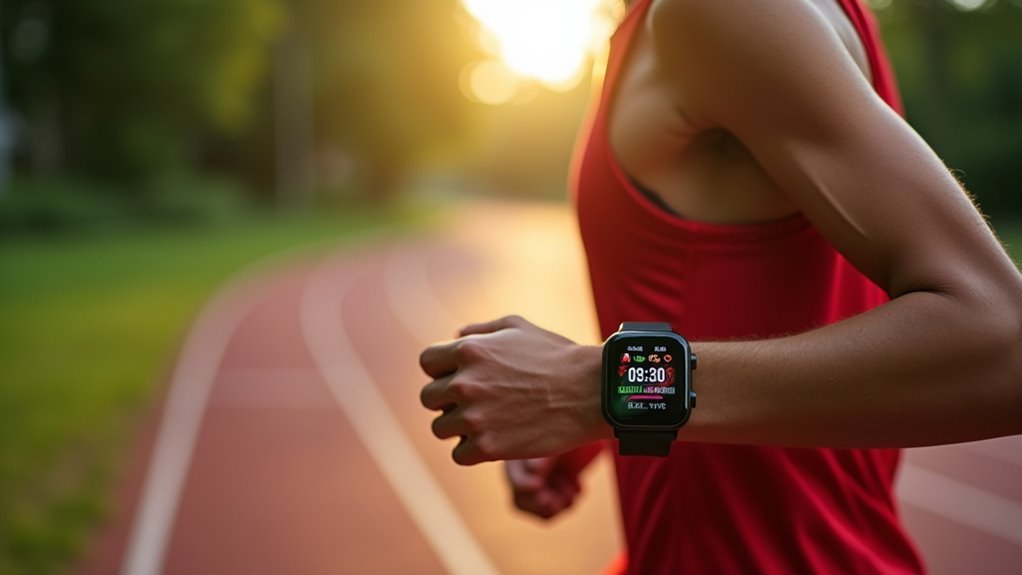You can measure your running fitness through several key performance indicators beyond just pace and distance. Monitor your heart rate variability, resting heart rate changes, and VO2 max to assess training status and recovery. Track biomechanical metrics like ground contact time, cadence, and vertical oscillation using GPS watches or wearables. Running power provides thorough intensity feedback, while stride length reflects your natural mechanics. These indicators reveal your true endurance potential and guide ideal training adjustments.
Base Fitness: Your Foundation for Endurance Performance

While many runners enthusiastically jump into speed work and intense intervals, base fitness forms the cornerstone of your endurance performance that’ll determine how well you handle everything that comes next.
You’ll develop this foundation through at least eight weeks of easy, conversational-pace running that builds your aerobic capacity without taxing your anaerobic systems.
During base training, your body adapts by increasing capillary density, enhancing mitochondrial function, and improving fat metabolism.
You’ll strengthen your musculoskeletal system while reducing injury risk through consistent, low-intensity volume.
This approach develops the cardiovascular efficiency that supports faster recovery between workouts and delays fatigue during intense training phases. Base training also provides an opportunity to focus on strength training, particularly during winter months when outdoor conditions may be challenging.
Your aerobic base ultimately enables better race performance and creates the metabolic flexibility needed for sustained endurance efforts.
Training Status: Balancing Progress and Recovery
Once you’ve established your aerobic base, monitoring your training status becomes essential for maximizing performance while avoiding the pitfalls of overtraining. Your training status reflects the delicate balance between workout stress and recovery, indicating whether you’re progressing efficiently or pushing too hard.
Key indicators include VO2 max changes, which reveal cardiovascular improvements, and heart rate variability (HRV), which signals your body’s stress and recovery levels. Resting heart rate fluctuations also provide valuable insights into your fitness trajectory.
Modern devices like Garmin and COROS integrate these metrics, offering real-time training status assessments. They’ll alert you when you’re overreaching or when you’ve achieved that sweet spot of enhanced training. Additionally, monitoring your lactate threshold provides crucial data about your body’s ability to clear lactate while running, helping determine optimal training heart rate zones.
Pay attention to these signals—they’ll help you make informed adjustments to training load and recovery strategies for sustained performance gains.
Running Fitness Across Different Intensity Zones

Understanding your body’s response to different training intensities transforms scattered workouts into strategic fitness gains.
You’ll develop distinct physiological adaptations across five heart rate zones, each serving specific training purposes.
Zone 1 (50-60% HRmax) supports recovery through very light activities.
Zone 2 (60-70% HRmax) builds your aerobic base by enhancing fat oxidation, muscular fitness, and capillary density without stressing your autonomic nervous system.
Zone 3 (70-80% HRmax) bridges aerobic and anaerobic systems, perfect for tempo runs.
Higher zones trigger different responses: Zone 4 (80-90% HRmax) and Zone 5 (90-100% HRmax) create lactate accumulation while boosting VO2max and anaerobic capacity through mitochondrial biogenesis.
You can measure intensity using pace, heart rate, or running power, with personalized LTHR-based zones offering the most accurate training prescriptions. Beginners should start at the lower end of their target heart rate zone and gradually increase intensity to avoid overexertion.
Ground Contact Time and Running Efficiency
You can measure your ground contact time using force plate treadmills for precision, high-speed cameras for detailed analysis, or GPS watches like Garmin Forerunner for convenient real-world tracking.
Once you’re collecting this data, you’ll want to focus on reducing the time your feet spend on the ground to boost your running efficiency.
Shorter ground contact times mean you’re generating force quickly and spending more time in flight, which translates to less energy waste and better performance. Research consistently shows that the fastest runners exhibit the shortest ground contact times, making this metric a reliable indicator of elite running ability.
GCT Measurement Techniques
Two primary approaches dominate the measurement of ground contact time: traditional laboratory methods that prioritize precision, and modern wearable technology that emphasizes accessibility.
Force plate treadmills and high-speed cameras deliver exceptional accuracy but require controlled environments and specialized equipment that’s typically inaccessible to everyday runners. These lab-based methods provide precise data yet may not reflect real-world running conditions.
Modern smartwatches from brands like Garmin and Apple Watch have revolutionized GCT measurement by making it available to recreational runners. In-shoe equipment provides another portable option that captures data during ordinary runs, though it may affect comfort and accuracy depending on shoe design.
While these devices don’t match laboratory precision, they offer continuous monitoring during actual training sessions. You’ll get real-time data that helps optimize your running form and track performance improvements.
This technological shift has democratized biomechanical analysis, allowing you to monitor GCT without expensive equipment or laboratory visits.
Improving Contact Time
Since ground contact time directly influences your running speed and efficiency, targeting this metric through specific training methods can reveal significant performance gains.
You’ll develop explosive force production and enhance your ability to minimize ground contact through structured approaches.
Here are three proven strategies to improve your contact time:
- Plyometric Training – Incorporate box jumps, bounds, and reactive exercises to build explosive power that reduces the time your feet spend on the ground during each stride.
- High-Cadence Drills – Practice quick turnover exercises at 180+ steps per minute to train your neuromuscular system for faster ground shifts.
- Sprint Intervals – Include short, high-intensity sprints in your training to develop rapid force production capabilities essential for shorter contact times.
Consistent application of these methods will improve your running economy and speed. Elite distance runners demonstrate that reduced contact time correlates with enhanced running efficiency, making this metric particularly valuable for performance optimization.
Cadence: The Key to Optimal Running Form

How many steps should you take each minute while running? Your cadence, or steps per minute (SPM), considerably impacts your performance and form.
Many runners aim for 180 SPM after Jack Daniels popularized this benchmark, but elite athletes actually range from 155 to 203 SPM.
Your preferred cadence typically falls 3-5% below ideal efficiency, increasing energy expenditure by 2-4%. Higher cadence promotes shorter strides, reducing overstriding and joint impact forces.
You’ll likely develop better posture alignment and midfoot striking patterns.
Don’t chase universal ideals—your height, leg length, and muscle strength influence your ideal rhythm. Research shows that cadence naturally increases by 4-5 steps per minute for each mile-per-hour increase in speed.
Use wearables to track your cadence, then make incremental 5-10% adjustments through metronome drills.
Vertical Oscillation and Energy Conservation
While cadence determines your stride frequency, your vertical oscillation reveals how efficiently you’re channeling that energy. This metric measures how much your body bounces up and down with each stride, typically ranging from 5-13 centimeters. You’ll want to aim for 5-10 cm for ideal energy conservation.
When your vertical oscillation exceeds 10 cm, you’re fundamentally wasting energy that could propel you forward. High vertical oscillation increases impact force upon ground contact, raising your risk of injury.
Here’s what causes excessive bounce and how to fix it:
- Overstriding – Landing too far ahead of your center of gravity creates unnecessary vertical movement.
- Weak core muscles – Poor stability forces compensatory bouncing during each footstrike.
- Incorrect cadence – Too slow turnover often correlates with higher vertical oscillation.
You can measure this using wearable devices or simple video analysis to enhance your running efficiency.
Running Power as a Comprehensive Performance Metric
Running power quantifies your mechanical energy output during runs, providing a more thorough performance indicator than speed or heart rate alone.
You’ll find that understanding power metrics, analyzing your power variability and consistency patterns, and systematically training with power data can transform how you approach running performance.
This metric captures the true effort you’re exerting regardless of terrain, wind conditions, or other external factors that traditionally skew pace-based training. Two runners maintaining identical pace may demonstrate vastly different power outputs due to biomechanical differences, revealing efficiency variations invisible to traditional metrics.
Understanding Running Power Metrics
As traditional metrics like pace and heart rate fall short in capturing the complete picture of running effort, power emerges as a revolutionary approach to understanding your true performance output.
Running power quantifies the mechanical work you’re doing per unit time, integrating horizontal velocity, vertical displacement, and acceleration into one all-encompassing measure.
You’ll find running power particularly valuable because it accounts for environmental factors that distort other metrics:
- Wind resistance compensation – Power readings remain consistent regardless of headwinds or tailwinds affecting your pace
- Gradient adjustment – Uphills and downhills don’t skew your effort measurement like they do with speed
- Real-time feedback – You get instant intensity data without waiting for heart rate lag during intervals
This makes power your most reliable indicator of actual running effort. Two critical metrics define the foundation of power-based training analysis: Functional Threshold Power for determining sustainable race intensities and Energy Cost of Running for measuring running efficiency.
Power Variability and Consistency
Though running power provides a more thorough view of your effort than traditional metrics, understanding its variability and consistency becomes essential for effective training application. Your running power output can vary dramatically—up to 40% for the same oxygen consumption—due to individual running economy differences.
| Factor | Impact on Power Reading |
|---|---|
| Running Economy | 40% variation possible at same VO₂ |
| Device Accuracy | Varies by manufacturer and terrain |
| External Conditions | Wind, incline, surface affect readings |
| Downhill Running | Higher variability, potential underestimation |
Consistency matters more than absolute accuracy for training purposes. While your device might read consistently high or low, repeatable measurements let you track genuine fitness changes and monitor training adaptations effectively over time. Power meters offer faster feedback on intensity changes compared to heart rate monitoring, which can lag behind actual effort adjustments during training sessions.
Training With Power Data
Beyond establishing consistent measurement patterns, you’ll need to understand how power data functions as your most thorough performance metric. Running power measures the actual mechanical work output per step in watts, giving you real-time insight into your effort across varied terrain that pace and heart rate can’t match.
Here’s how to maximize power data for training optimization:
- Establish personalized power zones for specific intensities like recovery, threshold, and VO2 max efforts to guide your workout structure.
- Compare power output with heart rate to identify efficiency improvements when the same watts occur at lower heart rates.
- Monitor training load precisely by tracking both muscular stress through power and cardiovascular strain, preventing overtraining while optimizing adaptation.
This dual-system approach transforms how you’ll manage intensity and recovery. Power data reflects both metabolic cost and muscle load simultaneously, providing a more complete picture of your physiological demands than individual metrics alone.
Stride Length and Natural Running Mechanics
When you analyze your running form, stride length emerges as one of the most fundamental metrics for understanding your natural biomechanics. Your stride length represents the distance between successive ground contacts of the same foot, doubling your step length to encompass two complete steps.
You can measure your stride length by running 100 meters on a track, counting your steps, then dividing the distance by your step count. Remember to warm up first for accurate readings.
Your natural stride reflects your height, age, fitness level, and individual mechanics—taller runners typically exhibit longer strides. Men generally achieve an average stride length of 2.9 feet while women average 2.3 feet during running activities.
Don’t force changes to your natural stride pattern, as this often leads to inefficiency or injury. Instead, use stride length monitoring to assess your form consistency and detect overstriding that could impact performance.
Training Load Monitoring and Adaptation
Training load monitoring represents the cornerstone of effective running performance management, allowing you to balance the delicate relationship between stress and recovery.
You’ll achieve ideal adaptations through systematic tracking of both internal and external metrics that reveal how your body responds to training demands.
Modern monitoring combines subjective measures with objective data to guide your training decisions:
- Internal Load Assessment – Use session RPE to gauge perceived exertion, while heart rate monitoring and training diaries track your physiological responses and recovery patterns over time.
- External Load Technology – GPS devices and accelerometers measure your running velocities, distances, and explosive movements, providing concrete data about training intensity.
- Adaptation Strategies – Implement periodization and progressive overload while incorporating recovery techniques to enhance your performance gains and prevent overtraining injuries.
Your individual responses to training load will vary even when following identical training programs, making personalized monitoring essential for optimal performance development.
Advanced Metrics for Elite Performance Tracking
You’ll find that power variability analysis reveals vital insights into your pacing consistency and energy distribution throughout your runs.
Your ground contact balance measurements can expose left-right asymmetries that indicate potential strength imbalances or injury risks before they become problematic.
These advanced metrics transform raw data into actionable feedback that separates elite performance tracking from basic fitness monitoring. Implementing hill intervals and speed work develops the snappier cadence needed to optimize your ground contact time measurements.
Power Variability Analysis
As elite runners push the boundaries of human performance, power variability analysis has emerged as a critical tool for understanding the consistency of energy output during training and competition.
You’ll find that maintaining stable power output reduces fatigue and improves performance, while high variability wastes precious energy.
Modern devices like Stryd power meters track your running power in real-time, providing valuable data for optimization. This technology helps you identify patterns and create training plans focused on consistency.
Key metrics you should monitor include:
- Standard deviation – measures how much your power output varies from your average
- Rolling standard deviation – tracks variability over shorter 30-second intervals
- Normalized power – provides a smoothed power value over longer durations
You’ll discover that consistent power output directly correlates with better running economy and reduced energy expenditure. Environmental conditions such as wind conditions can create significant power fluctuations, sometimes causing variations of up to 50 watts that impact your pacing strategy.
Ground Contact Balance
Balance reveals everything about your running form, and ground contact time balance stands as one of the most telling metrics for elite performance analysis. This metric compares how long each foot touches the ground, displayed as percentages like 48% left versus 52% right.
Perfect symmetry sits at 50/50, while Garmin considers 49.3-50.7% per foot as good balance. Your wearable device tracks this data through foot pods or smartwatch sensors, providing real-time feedback throughout entire runs.
When you exceed 52.2% on one side, you’re in the red zone for poor balance. Significant imbalances suggest you’re favoring one leg, potentially indicating strength asymmetries or injury risk.
You’ll notice imbalance increases with fatigue, but consistent patterns warrant investigation and targeted training adjustments. Elite runners generally maintain better ground contact balance, which contributes to their efficient running mechanics and superior performance outcomes.
Frequently Asked Questions
How Do Weather Conditions Affect Running Performance Metrics and Data Accuracy?
You’ll experience slower times when temperatures exceed 15°C, with humidity compounding heat stress. Wind resistance and solar radiation further impact your performance, while inaccurate weather data from distant stations affects measurement precision.
What’s the Difference Between GPS Watch Metrics and Treadmill Running Data?
Your GPS watch uses satellite signals outdoors but switches to accelerometers indoors, making treadmill data more accurate for indoor runs since it’s based on calibrated belt revolutions and mechanical sensors.
How Often Should Recreational Runners Analyze Their Performance Metrics for Improvement?
You should analyze your performance metrics weekly to track progress effectively. Don’t obsess over daily fluctuations, but review trends monthly for bigger picture insights. This frequency prevents data overload while maintaining improvement focus.
Can Running Metrics Help Predict Injury Risk Before Symptoms Appear?
Yes, you can predict injury risk using running metrics before symptoms appear. Machine learning models analyze your biomechanics, training loads, fatigue levels, and technique changes to achieve 71-79% accuracy in forecasting potential injuries.
Do Running Metrics Vary Significantly Between Trail Running and Road Running?
Your running metrics change dramatically between trail and road running. You’ll see shorter strides, higher cadence, and slower paces on trails, while you’ll maintain longer strides and faster speeds on roads.
In Summary
You’ve got the tools to transform your running performance by tracking these essential metrics. Don’t overwhelm yourself—start with base fitness and cadence, then gradually add power and advanced indicators as you progress. Remember, consistency in monitoring beats perfection. You’ll see real improvements when you balance training load with proper recovery. Trust the data, listen to your body, and you’ll reveal your true running potential through smart, metric-driven training.





Leave a Reply